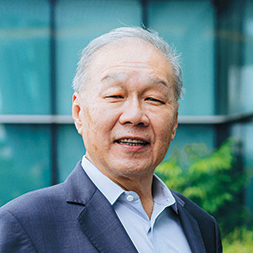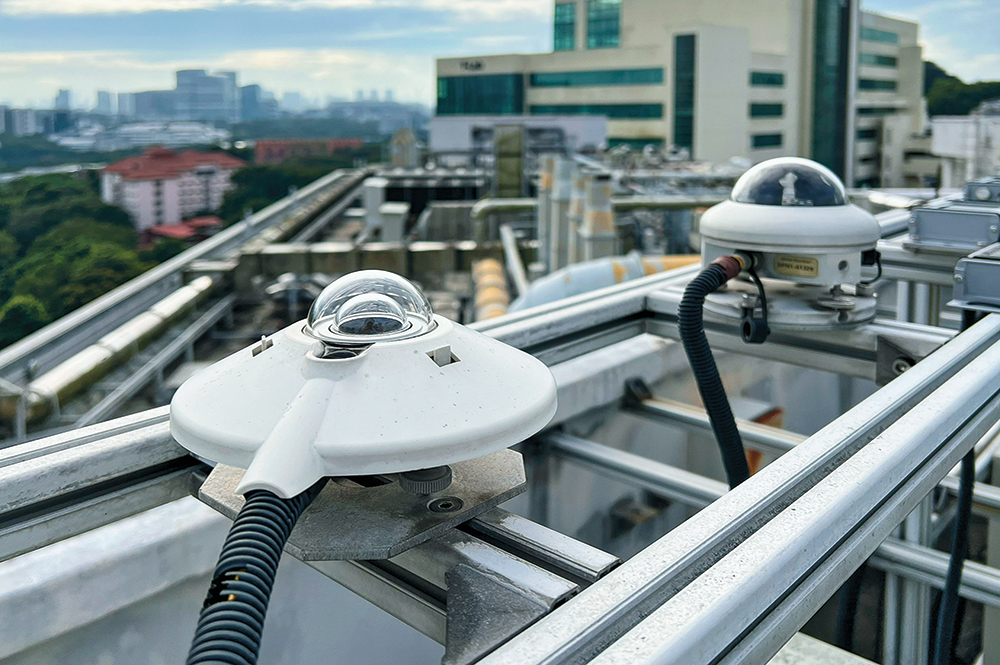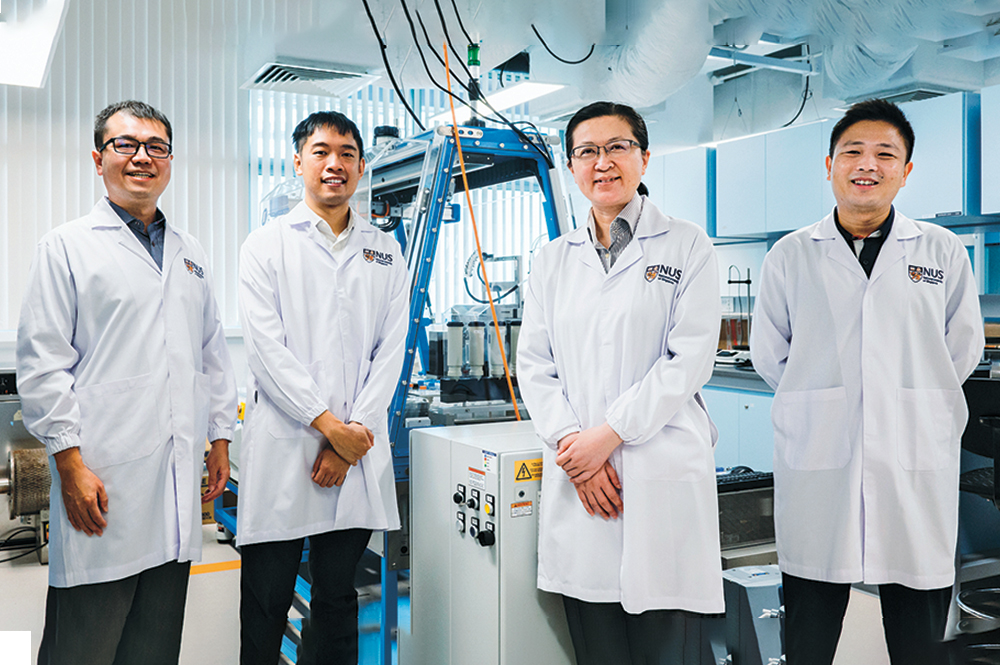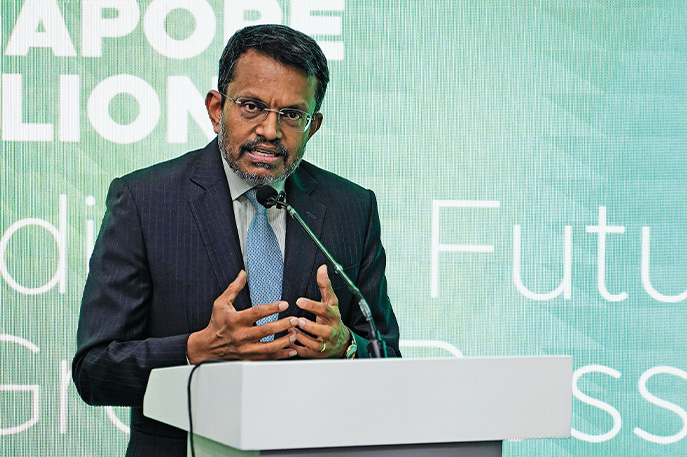A STATEMENT OF INTENT
Recent changes at the senior leadership level have laid down a marker of NUS’ ambition to advance sustainable development and contribute to the global fight against climate change. In August 2022, former Faculty of Engineering Dean Professor Low Teck Seng stepped down from his post as Chief Executive Officer of the National Research Foundation to assume the brand-new position of Senior Vice President (Sustainability & Resilience) at NUS. His role is to serve as a catalyst in facilitating collaborations between different NUS research institutes, as well as with industry partners, to augment Singapore’s climate resilience and sustainability through the development of novel mitigation and adaptation solutions.
“We will look towards achieving thought leadership in sustainability by NUS with these key work streams — research, education, carbon net-zero campus, and building a culture of consciousness of sustainability and resilience. Looking into the future with the outcomes from our efforts, and with the right technological solutions in place, we will be able to build up resilience against the impact of climate change,” said Prof Low prior to returning to NUS. “I hope to bring together colleagues from many different faculties to address the concept of resilience. This could be via research which straddles different disciplines — for example, the nexus of energy, water, waste, environment and food security. There are many areas we need to examine as these are existential issues for Singapore.”
Prof Low is also a member of the University Sustainability and Climate Action Council, which was formed in 2021 in response to the increasing urgency of climate change. Made up of faculty and staff from a wide spectrum of disciplines, the Council coordinates the University’s activities across the fields of education, research, innovation and enterprise, campus operations and administration, and community engagement, to catalyse solutions for greater sustainability impact.
The Council is chaired by NUS President Professor Tan Eng Chye (Science ’85), who touched on NUS’ growing momentum in this area in an interview with
The Straits Times. “As a university at the forefront of scientific research, we are at a great vantage point to drive change and test cutting-edge practices and solutions by serving as living laboratories for experimentation. Green research is an exciting new frontier offering opportunities for interdisciplinary collaboration,” he said. “By harnessing the knowledge and expertise of our faculty and researchers from different disciplines, we can make significant contributions to enhance the climate resilience and sustainability of Singapore.”

Looking into the future with the outcomes from our efforts, and with the right technological solutions in place, we will be able to build up resilience against the impact of climate change.
Professor Low Teck Seng, Senior Vice President (Sustainability & Resilience), NUS
INFUSING SUSTAINABILITY — AND TECHNOLOGY — INTO THE CURRICULA
In the educational arena, NUS has rolled out a raft of undergraduate and postgraduate courses to empower students to contribute to the sustainability movement. For example, a new degree programme by the College of Design and Engineering (CDE), the Bachelor of Engineering (Infrastructure and Project Management), seeks to nurture built environment professionals with the interdisciplinary knowledge and skills to create sustainable urban environments in the face of the changing climate. It covers modules in engineering, design, management, technology, building science and law, with electives focusing on digital technologies like building information modelling and smart facilities management. Alternatively, interested students can pursue a Second Major in Sustainable Urban Development or a Minor in Meteorology and Climate Science, among other options.
A variety of sustainability-themed master’s programmes is also available to postgraduate students. New offerings include the Master of Science (Energy Systems), which combines understanding of energy technology and innovation management to facilitate decision-making in energy solutions and investment; and the Master of Science (Sustainable and Green Finance), launched by NUS Business School in collaboration with NUS’ Sustainable and Green Finance Institute. The latter programme extends conventional, profit-maximising finance models to incorporate environmental, social and governance (ESG) considerations into business and investment decisions. Using various measurement tools which harness big data and analytics, students are trained to assess business impacts on society and the environment, identify opportunities for sustainable investing and propose novel green financial instruments.
Not forgetting the importance of lifelong learning and workforce upskilling, NUS is ramping up its continuing education programmes in this area as well. For instance, C-suite executives can enrol in the five-day programme, Leading in Sustainability and Climate Change: Lessons from the Little Green Dot. Administered by the School of Continuing and Lifelong Education (SCALE), it gives participants a better understanding of the science behind climate change, relevant regulatory and technical aspects, and how to champion sustainable business practices in their organisations. Other bite-sized courses allow working adults to obtain certification in specialised topics such as green fintech, urban farming biotechnology, and key analytical tools for biodiversity conservation and nature-based climate solutions.
SINGAPORE’S PATH TO NET-ZERO
WHAT HAS SINGAPORE PLEDGED?
- To cut greenhouse gas emissions to 60 million tonnes in 2030
(updated in October 2022 from the previous target of 65 million tonnes)
- To achieve net-zero emissions by 2050
The Government submitted its enhanced climate targets to the UNFCCC at the COP27 summit.
THE CHALLENGE > Singapore’s alternative-energy disadvantaged status
-
Serious difficulties in pursuing renewable energy sources (e.g., solar, hydroelectric, wind, nuclear, geothermal) due to geographical limitations
-
These include small land area, relatively flat and low-lying terrain, low wind speeds, high urban population density and a lack of natural resources
![]()
"Even though Singapore only accounts for just 0.1 per cent of global emissions, we want to do our part in the global effort to address the climate crisis and steward our resources for future generations.”
Mr Lawrence Wong, Deputy Prime Minister and Minister for Finance, at the Singapore International Energy Week in October 2022
> READ ON to find out how NUS supports this transition!
LEVERAGING NATURE THROUGH TECH
One might ask, what are nature-based solutions to climate change? They refer to the conservation, restoration and responsible management of landscapes and ecosystems to remove carbon dioxide from the atmosphere. Examples include protecting or restoring forests and mangroves, as well as practising regenerative agriculture such as no-till farming and cover crop rotation. Based on research by global non-profit The Nature Conservancy, natural climate solutions can provide over one-third of the greenhouse gas emissions reductions needed by 2030 to stabilise warming to below two degrees Celsius.
At NUS, research in this field is led by its Centre for Nature-based Climate Solutions (CNCS), housed within the Faculty of Science. Ms Audrey Tan (Arts and Social Sciences ’13), Science Communication and Outreach Lead at CNCS as well as the Tropical Marine Science Institute (TMSI), discussed the importance of nature-based solutions — especially reforestation — in a TODAY commentary which was published on 17 November 2022. “[I]n the near-term, even as Singapore contributes to the research and development of emerging low-carbon technologies, it would need to buy carbon credits to meet its eventual goal of having its emissions reach 60 million tonnes in 2030, before coming down to net-zero by 2050,” she noted. “Nature … has a ready-made ‘technology’ that does exactly that: trees. Reforestation projects can help to draw down the amount of planet-warming carbon dioxide (CO2) in the atmosphere. Each tonne of CO2 removed by the reforestation project could be sold as a carbon credit, which can be bought by another country who can claim the emissions reduction as its own.”
Two new initiatives demonstrate CNCS’ resolve to grow the carbon market. In September 2022, together with ST Engineering Geo-Insights (known for its satellite data and geospatial analytics capabilities), CNCS launched the Carbon Prospecting Dashboard (CarbonProspecting.org). This is an open-access platform that maps out high-quality nature-based carbon credit projects worldwide.
Policymakers and investors can use this first-of-its-kind dashboard to identify the location of carbon-rich natural ecosystems like forests and mangroves; calculate the estimated yield of carbon projects and their financial return on investment; as well as quantify other positive benefits of the projects, such as improving food security, ensuring clean water supply and conserving key biodiversity areas.

In the near-term, even as Singapore contributes to the research and development of emerging low-carbon technologies, it would need to buy carbon credits to meet its eventual goal of having its emissions reach 60 million tonnes in 2030, before coming down to net-zero by 2050. Nature … has a ready-made ‘technology’ that does exactly that: trees.
Ms Audrey Tan, an NUS climate science communicator, in a TODAY commentary

E-LEARNING: UNLOCKING ENVIRONMENTAL BENEFITS
When it comes to the intersection of technology and sustainability in education, there is more to it than learning about the latest green tech inventions. The way such learning is delivered — specifically, the switch to remote learning during the COVID-19 pandemic — also matters.
In a study by the United Kingdom-based Open University, researchers found that the provision of online learning courses produced carbon profiles that were almost 90 per cent lower than for face-to-face classes. Environmental gains were derived from a mix of factors, including reduced air pollution as students and staff no longer had to travel to and from campus; reduced deforestation by eliminating the need for paper; reduced energy consumption in university buildings; and reduced raw material requirements (e.g., plastic, metal, wood, concrete) to construct and upgrade those facilities.
The widespread adoption of virtual learning may have been forced during the pandemic, but it had the benefit of lowering the carbon footprint of individuals as well as educational institutions. Now that face-to-face (or hybrid) learning is back in full force, discussions are ongoing about how best to balance the need for physical interaction with the use of digital learning to make education more accessible and to help achieve urgent environmental goals. It is a complicated issue, but one that deserves scrutiny.
A team from CNCS, including its Director Professor Koh Lian Pin (Science ’01) and Ms Tan, also represented NUS at the COP27 summit in November. There, they launched the Carbon Market Integrity Research and Development Programme Singapore (Carbon Integrity SG), a five-year research project to support the establishment and monitoring of high-quality nature-based carbon projects across Southeast Asia. Under this $15 million programme, which is funded primarily by the National Research Foundation, CNCS researchers will work with partners — including other universities, government agencies and corporations — to set up a network of forest carbon monitoring plots around the region. They will use high-tech tools like Light Detection and Ranging (LiDAR) to accurately measure biomass carbon stocks in those habitats, thus improving carbon yield estimates on the Carbon Prospecting Dashboard.
![]()
By tapping into Southeast Asian expertise in forestry, geospatial technology and other sectors, we can tailor global models to our unique context.
Professor Koh Lian Pin, Director, NUS’ Centre for Nature-based Climate Solutions, on the Carbon Integrity SG initiative
According to Prof Koh — who also heads TMSI and sits on the University Sustainability and Climate Action Council — the key advantage of Carbon Integrity SG is that it enables the development of more precise, region-specific carbon estimation models for different habitat types, instead of relying on a pantropic or one-size-fits-all approach. “By tapping into Southeast Asian expertise in forestry, geospatial technology and other sectors, we can tailor global models to our unique context. The collaborations will help to improve the credibility of nature-based carbon projects in Southeast Asia, which is home to many natural ecosystems, including rainforests, peat swamps and mangroves,” he said in a press release. “Carbon Integrity SG’s work will give investors greater confidence in the quality of nature-based carbon projects, helping to promote the conservation of these important habitats.”
HIGH HOPES FOR HYDROGEN
While nature-based climate solutions may provide the quickest route to cutting carbon emissions, a longer-term outlook is also evident among NUS faculty and researchers who are intent on developing and implementing cutting-edge sustainable technologies. This is the express goal of the Keppel Infrastructure–NUS Low Carbon Living Laboratory, which was established to create, testbed and scale up the deployment of commercially-viable innovations in energy management and decarbonisation.
Under this on-campus collaboration, Keppel Infrastructure and NUS have jointly identified four project foci:
- A hybrid microgrid that integrates renewable and distributed energy resources (e.g., solar photovoltaic systems) into the main power grid without disruption to the electricity supply
- Smart electric vehicle (EV) charging algorithms that balance the needs and constraints of the existing electrical network
- Next-generation district cooling systems to help buildings save energy and space, as well as reduce the urban heat island effect
- Enhanced pre-treatment of seawater before the desalination process, for better carbon dioxide sequestration and scalant removal
Another promising sustainable tech trend is using hydrogen to generate energy as an alternative to fossil fuels. At NUS’ Centre for Hydrogen Innovations (CHI), researchers are exploring ways to make hydrogen more affordable and to accelerate the large-scale adoption of this clean-burning molecule. Current projects include, for example, finding more cost-effective and energy-efficient methods of converting ammonia into hydrogen; evaluating infrastructure and pipelines to ensure hydrogen’s safe storage, transport and distribution; and collaborating with industry partners to test new hydrogen applications, be it as a transportation fuel or as a raw material for chemicals production.

As part of the Singapore Green Plan 2030, the city-state aims to position itself as a
LEADING CARBON SERVICES HUB — home to firms offering an array of carbon-related services including but not limited to the generation and trade of carbon credits.
 Solar irradiance sensors used in the solar forecasting model developed by SERIS. (Photo: SERIS)
Solar irradiance sensors used in the solar forecasting model developed by SERIS. (Photo: SERIS)
HERE COMES THE SUN
Due to its land scarcity, Singapore has been forced to get creative to harvest as much sunlight as possible and increase solar power capacity. Such ingenuity seems to be paying off, with news that the Energy Market Authority (EMA) will incorporate a new, made-in-NUS solar forecasting model into the national power system in 2023.
NUS’ Solar Energy Research Institute of Singapore (SERIS) has developed a model capable of accurately predicting the country’s solar irradiance — the amount of light energy received from the sun — up to 24 hours in advance. By collecting and aggregating data from various sources, including irradiance sensors installed island-wide, satellite imagery and machine learning algorithms, the model was found to have an average error rate below 10 per cent for one-hour forecasts.
Following SERIS’ successful year-long trial of the model, EMA plans to adopt it later this year as part of a broader strategy to boost the reliability and resilience of Singapore’s power grid. Anticipating solar power output ahead of time could increase its share of the energy mix, allow power generation plants to adjust their output accordingly (e.g. lowering output on a sunny day), and better match electricity supply with demand.
 Prof Liu Bin (second from right) with fellow researchers at the NUS Centre for Hydrogen Innovations.
Prof Liu Bin (second from right) with fellow researchers at the NUS Centre for Hydrogen Innovations.
Professor Liu Bin (Science (PhD) ’01) is the Director of CHI, which commenced operations in July 2022. “Through the new Centre, we aim to advance hydrogen-related R&D in Singapore to solve high-value problems that can significantly bring down the cost of green hydrogen as a fuel. At the same time, we will provide talent training for both academia and industry to grow the pool of hydrogen-related researchers, as well as upskill the workforce to prepare Singapore for a hydrogen economy,” she said upon CHI’s opening. A member of the University Sustainability and Climate Action Council, Prof Liu also oversees NUS’ sustainability research cluster in her capacity as Senior Vice Provost (Faculty & Institutional Development).
![]()
Through the new Centre, we aim to advance hydrogen-related R&D in Singapore to solve high-value problems that can significantly bring down the cost of green hydrogen as a fuel.
Prof Liu Bin, Director, Centre for Hydrogen Innovations, NUS
In related news, a team led by Associate Professor Xue Jun Min from CDE’s Department of Materials Science and Engineering is making waves in the global scientific community for having devised a revolutionary technique of extracting hydrogen from water. They discovered that light can trigger or enhance the catalytic activity of a nickel oxyhydroxide-based material commonly used in water electrolysis (i.e. the splitting of water into hydrogen and oxygen). “This should require less energy in the electrolysis process, and it should be much easier using natural light,” said Assoc Prof Xue on his team’s findings, which were published in the journal Nature in October 2022. “More hydrogen can be produced in a shorter amount of time, with less energy consumed.”
 Mr Ravi Menon, Managing Director of MAS, at the COP27 summit. (Photo: COP27 SG Pavilion)
Mr Ravi Menon, Managing Director of MAS, at the COP27 summit. (Photo: COP27 SG Pavilion)
A GREEN FINANCE HUB IN THE MAKING
Developing and deploying decarbonisation technologies does not come cheap. According to a McKinsey report, around US$9.2 trillion per year will need to be spent globally on physical assets for energy and land-use systems to reach net-zero by 2050. Roughly one-third of that amount will need to be spent in Asia — and as a leading global financial centre, Singapore is well-placed to contribute to the effort.
Speaking at the launch of the COP27 Singapore Pavilion, Mr Ravi Menon (Arts and Social Sciences ’87), Managing Director of the Monetary Authority of Singapore (MAS), outlined several measures Singapore is taking to mobilise capital and put the region on the path to net-zero. Technology plays a key role in creating “credible disclosure and transition plans”, said Mr Menon. “We must give investors confidence to invest in the transition, especially given concerns around ‘greenwashing’ [exaggerated environmental claims]. … Singapore has been contributing to international efforts towards comparable sustainability disclosures and sound climate data and metrics.”
For example, MAS is currently developing an artificial intelligence (AI) tool dubbed NovA! to help financial institutions assess the performance of companies which have taken out sustainability-linked loans. AI-derived insights would help define and track a firm’s key ESG metrics and detect greenwashing, while natural language processing would cut the time spent collecting, processing and analysing data. Once deployed, NovA! will join other MAS digital solutions in the pipeline, such as a blockchain-based registry to verify the provenance of ESG certifications, and an online marketplace connecting the global green fintech community.